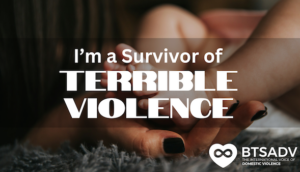‘Does the pain ever really go away or will I just get better at managing it? Am I managing it or have I accepted a new norm? Maybe others are right, and I’m just being overly sensitive? It’s not that big of a deal, or is it? I don’t have any visible wounds so maybe it’s not abuse… I’m not a victim of domestic violence, no, I can’t be a victim of domestic violence. That’s not me.’
Thoughts like this have kept me up late on many occasions. Questioning my reality. Questioning my perspective. Questioning my sanity. What is domestic violence? At what point do I simply ignore behavior rather than use my voice to tell someone they are hurting me?
When examining various types of abuse, it’s not always clear. Some of the “hits” that hurt the most leave invisible wounds. Invisible wounds make it incredibly difficult to identify behavior as abusive.
Domestic violence is defined as a pattern of behavior that is used to gain and maintain power and control over a current or former intimate partner. Normalization of domestic violence is the process in which domestic violence is considered normal or regular behavior.
How is domestic violence normalized in abusive relationships?
The Normalization of domestic violence is any behavior that makes you uncomfortable and scared to speak up about something simple. If you live with your partner, this may show up in behaviors like purposefully leaving dirty dishes, tampering with the thermostat, removing smoke detectors, or having constant loud noises during normal sleeping hours. The behavior itself can be considered annoying or disruptive, but it becomes abusive when not talked about or when talking about it results in retaliatory behavior. Have you ever told yourself, ‘Geeze, had I know it was going to escalate like this, I would have just kept my mouth shut?’ Welcome to conditioning; small acts, over time, teach victims how to behave and what to accept from abusive people. This process between abuser and victim is called conditioning. The process of this being accepted in society is called normalization.
How does the abuser normalize domestic violence?
Another reason why domestic violence has been normalized is due to the cycle of abuse. The abuser is often inconsistent in their reaction to a victim. Sometimes a behavior is rewarded with love. Other times it is rewarded with, well, not love. The inability to know which behavior will ensue often keeps victims in abusive situations.
For example, in a physically abusive relationship, the abuser might hit their victim. The victim is then covered with bruises. The abuser might buy flowers, apologize and promise never to do it again, while also saying that if the victim had just listened the first time, then the bruises could have been avoided altogether. This emotional tug of war is confusing to the victim as it creates a situation where the victim convinces themselves that they are at fault and their abuser must care, after all. It was just a mistake; nobody is perfect. Right?
How does society normalize domestic violence?
Domestic violence is often normalized by the stigma that prevents people from talking about it. Talking about domestic violence can often be dangerous for survivors and compromise their safety. The abuser may choose to respond to the survivor’s decision to share their story by increasing abusive behavior or exerting control in other, perhaps more covert, ways. However, talking about domestic violence can also be incredibly empowering. It helps survivors to identify people with shared experiences or advocates who can help them through their healing process. Speaking from experience, it takes a lot of energy to break free from an abusive situation and even more energy to continue on a path of recovery.
Making jokes about abuse or incorporating violence in our language, like calling a man’s undershirt a “wife-beater,” further serve to silence victims by showing us that our experiences are invalid or, even worse, funny.
The Hotline.org reports, “[Twenty-four] people per minute are victims of rape, physical violence or stalking by an intimate partner in the United States,” which translates to more than 12 million people each year. This statistic indicates that domestic violence is more common than we think, as these statistics only take into account people who broke their silence.
I know I read about domestic violence for years before I was even able to embrace the words, “I’m a survivor of domestic violence.” Truth be told, all the people I spoke to about my experience made me feel that the abuse I endured was my fault. What began as comments eventually escalated to physical abuse, including being held up against a wall and having a loaded gun shoved in my face. It took me eight years to acknowledge this as abuse. It seems obvious now that this is unacceptable behavior, but everything escalated over time and wasn’t easy to identify.
What can we do to stop the normalization of domestic violence?
Talk about it. You are not alone. According to the CDC, “over 43 million women and about 38 million men experience psychological aggression by an intimate partner in their lifetime.” It’s time to support people who break their silence. Sometimes sharing your story of recovery will be a page in someone else’s survival guide. People are being hurt without knowing they deserve better.
If you or someone you know is in an abusive relationship, there is help. You can visit the Break the Silence Against Domestic Violence website at www.breakthesilencedv.org or chat with one of our helpline advocates at 855-287-1777.
========
What’s YOUR Raw Truth?
Sharing our stories can be incredibly empowering while also helping others connect with survivors who have similar experiences. If you are inspired to share your story with us, submit here. You can choose to remain anonymous.
You can also donate to BTSADV here.










